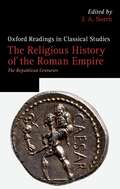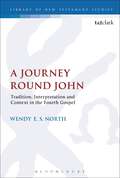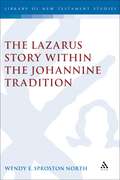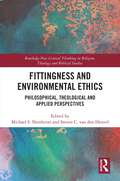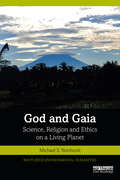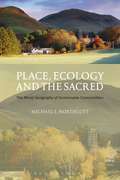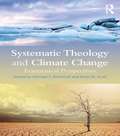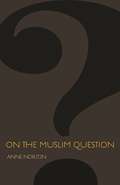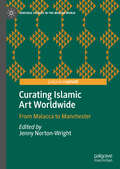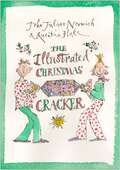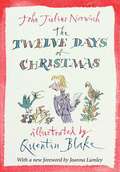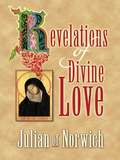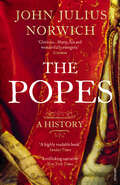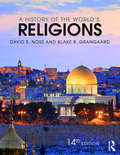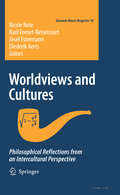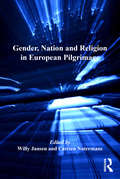- Table View
- List View
The Religious History of the Roman Empire: The Republican Centuries (Oxford Readings in Classical Studies)
by J. A. NorthThe Religious History of the Roman Empire: The Republican Centuries is the second Oxford Readings in Classical Studies volume on the religious history of the Roman Empire, accompanying the volume on paganism, Judaism, and Christianity. This volume presents fourteen chapters dealing with aspects of the religious life of Republican Rome between c. 500 BCE and the fall of the Republican constitution in c. 30 BCE. The topics covered include Iron Age rituals (Christopher Smith); Roman Priesthood (John Scheid; Mary Beard); religion and war (Jörg Rüpke); religious behaviour in the context of polytheism (Andreas Bendlin); religious ritual in early and middle Republic (John North); Italian warfare practices (Olivier de Cazanove); the role of women (Rebecca Flemming); sacrificial ritual in Roman poetry (Denis Feeney); the centuriation-ritual (Daniel Gargola); Roman divination (Mary Beard); Augustan Peace and the stars (Alfred Schmid); the great cult-places of Italy (John Scheid); the grove of Pesaro (Filippo Coarelli). Originally published between 1981 and 2011, these chapters provide a vivid picture of key issues under discussion in this period, providing a missing link in the historiography of Roman republican religion. A central question concerns the balance to be found between ritual and belief, both problematic concepts in interpreting this religious tradition. While there can be no question that the performance of rituals was a regular traditional activity to which Romans attached great significance, particularly those who were in a responsible position as priests or senators, the later years of the Republic increasingly saw religious issues taken as matters for debate, and books on religious themes, unknown before the age of Cicero and Varro, began to appear.
A Journey Round John: Tradition, Interpretation and Context in the Fourth Gospel (The Library of New Testament Studies #534)
by Wendy E. NorthIn A Journey Round John Wendy E. S. North considers a range of themes relevant to the interpretation of the Fourth Gospel. First, the relationship between the Gospel and 1 John. North explores the value of the Epistle as a means of identifying traditional material the evangelist knew; on which basis she appeals to 1 John to account for the form of Jesus' prayer in chapter 11. Second, John's Christology in which North looks to John's cultural roots in monotheistic Judaism to understand his capacity to align Jesus with God. Third, the crucial issue of 'the Jews' in John, where North clarifies the data by observing a narrative logic in John's use of the expression. Fourth, North identifies John's 'anticipated' eschatology as a consolation strategy aimed at a readership struggling under life-threatening circumstances in the absence of Jesus. Finally, North looks at John and the Synoptics, and demonstrates how evidence drawn from the Gospel itself can serve to indicate whether or not John composed directly on the basis of the Synoptic record. This collection draws together a number of ground-breaking studies from over thirty years of work on the Fourth Gospel, presenting a coherent development of thought on this crucial Christian text.
The Lazarus Story within the Johannine Tradition (The Library of New Testament Studies #212)
by Wendy E. NorthThis historical-critical study of the Gospel of John and the First Epistle of John challenges the commonly held view that the first Johannine epistle is related to the Gospel. Sproston argues that the two writings are indirectly related through a common Johannine tradition. A comparison of the two therefore allows traditional material in the evangelist's work to be isolated, enhancing our understanding of the creative processes involved in its composition. The account of the raising of Lazarus is rigorously analysed as a test case for this kind of analysis.
Fittingness and Environmental Ethics: Philosophical, Theological and Applied Perspectives (Routledge New Critical Thinking in Religion, Theology and Biblical Studies)
by Michael S. NorthcottThis volume focuses on ‘fittingness’ as an ethical-aesthetical idea, and in particular examines how the concept is beneficial for environmental ethics. It brings together an innovative set of contributions to argue that fittingness is a significant but under-investigated facet of human ethical deliberation with both ethical and aesthetic dimensions. In widely diverse matters – from architecture to table manners – individuals and communities make decisions based on ‘fittingness’, also expressed in related terms, such as appropriateness, prudence, temperance, and mutuality. In the realm of environmental ethics, fittingness denotes a relation between conscious embodied persons and their habitats and is of relevance to judgements about how humans shape, and take up with, the non-human environment, and hence to ethical decisions about the development and use of the environment and non-human creatures. As such, fittingness can be of great benefit in reframing human relationships to the non-human, stimulating a way of living in the world that is fitting to the preservation of its fruitfulness, goodness, beauty, and truth.
God and Gaia: Science, Religion and Ethics on a Living Planet (Routledge Environmental Humanities)
by Michael S NorthcottGod and Gaia explores the overlap between traditional religious cosmologies and the scientific Gaia theory of James Lovelock. It argues that a Gaian approach to the ecological crisis involves rebalancing human and more-than-human influences on Earth by reviving the ecological agency of local and indigenous human communities, and of nonhuman beings. Present-day human ecological influences on Earth have been growing at pace since the Scientific and Industrial Revolutions, when modern humans adopted a machine cosmology in which humans are the sole intelligent agency. The resultant imbalance between human and Earthly agencies is degrading the species diversity of ecosystems, causing local climate changes, and threatens to destabilise the Earth as a System. Across eight chapters this ambitious text engages with traditional cosmologies from the Indian Vedas and classical Greece to Medieval Christianity, with case material from Southeast Asia, Southern Africa and Great Britain. It discusses concepts such as deep time and ancestral time, the ethics of genetic engineering of foods and viruses, and holistic ecological management. Northcott argues that an ontological turn that honours the differential agency of indigenous humans and other kind, and that draws on sacred traditions, will make it is possible to repair the destabilising impacts of contemporary human activities on the Earth System and its constituent ecosystems. This book will be of considerable interest to students and scholars of the environmental humanities, history, and cultural and religious studies.
God and Gaia: Science, Religion and Ethics on a Living Planet (Routledge Environmental Humanities)
by Michael S NorthcottGod and Gaia explores the overlap between traditional religious cosmologies and the scientific Gaia theory of James Lovelock. It argues that a Gaian approach to the ecological crisis involves rebalancing human and more-than-human influences on Earth by reviving the ecological agency of local and indigenous human communities, and of nonhuman beings. Present-day human ecological influences on Earth have been growing at pace since the Scientific and Industrial Revolutions, when modern humans adopted a machine cosmology in which humans are the sole intelligent agency. The resultant imbalance between human and Earthly agencies is degrading the species diversity of ecosystems, causing local climate changes, and threatens to destabilise the Earth as a System. Across eight chapters this ambitious text engages with traditional cosmologies from the Indian Vedas and classical Greece to Medieval Christianity, with case material from Southeast Asia, Southern Africa and Great Britain. It discusses concepts such as deep time and ancestral time, the ethics of genetic engineering of foods and viruses, and holistic ecological management. Northcott argues that an ontological turn that honours the differential agency of indigenous humans and other kind, and that draws on sacred traditions, will make it is possible to repair the destabilising impacts of contemporary human activities on the Earth System and its constituent ecosystems. This book will be of considerable interest to students and scholars of the environmental humanities, history, and cultural and religious studies.
Place, Ecology and the Sacred: The Moral Geography of Sustainable Communities
by Michael S. NorthcottPeople are born in one place. Traditionally humans move around more than other animals, but in modernity the global mobility of persons and the factors of production increasingly disrupts the sense of place that is an intrinsic part of the human experience of being on earth. Industrial development and fossil fuelled mobility negatively impact the sense of place and help to foster a culture of placelessness where buildings, fields and houses increasingly display a monotonous aesthetic. At the same time ecological habitats, and diverse communities of species are degraded. Romantic resistance to the industrial evisceration of place and ecological diversity involved the setting aside of scenic or sublime landscapes as wilderness areas or parks. However the implication of this project is that human dwelling and ecological sustainability are intrinsically at odds. In this collection of essays Michael Northcott argues that the sense of the sacred which emanates from local communities of faith sustained a 'parochial ecology' which, over the centuries, shaped communities that were more socially just and ecologically sustainable than the kinds of exchange relationships and settlement patterns fostered by a global and place-blind economy. Hence Christian communities in medieval Europe fostered the distributed use and intergenerational care of common resources, such as alpine meadows, forests or river catchments. But contemporary political economists neglect the role of boundaried places, and spatial limits, in the welfare of human and ecological communities. Northcott argues that place-based forms of community, dwelling and exchange – such as a local food economy – more closely resemble evolved commons governance arrangements, and facilitate the revival of a sense of neighbourhood, and of reconnection between persons and the ecological places in which they dwell.
Place, Ecology and the Sacred: The Moral Geography of Sustainable Communities
by Michael S. NorthcottPeople are born in one place. Traditionally humans move around more than other animals, but in modernity the global mobility of persons and the factors of production increasingly disrupts the sense of place that is an intrinsic part of the human experience of being on earth. Industrial development and fossil fuelled mobility negatively impact the sense of place and help to foster a culture of placelessness where buildings, fields and houses increasingly display a monotonous aesthetic. At the same time ecological habitats, and diverse communities of species are degraded. Romantic resistance to the industrial evisceration of place and ecological diversity involved the setting aside of scenic or sublime landscapes as wilderness areas or parks. However the implication of this project is that human dwelling and ecological sustainability are intrinsically at odds. In this collection of essays Michael Northcott argues that the sense of the sacred which emanates from local communities of faith sustained a 'parochial ecology' which, over the centuries, shaped communities that were more socially just and ecologically sustainable than the kinds of exchange relationships and settlement patterns fostered by a global and place-blind economy. Hence Christian communities in medieval Europe fostered the distributed use and intergenerational care of common resources, such as alpine meadows, forests or river catchments. But contemporary political economists neglect the role of boundaried places, and spatial limits, in the welfare of human and ecological communities. Northcott argues that place-based forms of community, dwelling and exchange – such as a local food economy – more closely resemble evolved commons governance arrangements, and facilitate the revival of a sense of neighbourhood, and of reconnection between persons and the ecological places in which they dwell.
Fittingness and Environmental Ethics: Philosophical, Theological and Applied Perspectives (Routledge New Critical Thinking in Religion, Theology and Biblical Studies)
by Michael S. Northcott Steven C. Van Den HeuvelThis volume focuses on ‘fittingness’ as an ethical-aesthetical idea, and in particular examines how the concept is beneficial for environmental ethics. It brings together an innovative set of contributions to argue that fittingness is a significant but under-investigated facet of human ethical deliberation with both ethical and aesthetic dimensions. In widely diverse matters – from architecture to table manners – individuals and communities make decisions based on ‘fittingness’, also expressed in related terms, such as appropriateness, prudence, temperance, and mutuality. In the realm of environmental ethics, fittingness denotes a relation between conscious embodied persons and their habitats and is of relevance to judgements about how humans shape, and take up with, the non-human environment, and hence to ethical decisions about the development and use of the environment and non-human creatures. As such, fittingness can be of great benefit in reframing human relationships to the non-human, stimulating a way of living in the world that is fitting to the preservation of its fruitfulness, goodness, beauty, and truth.
Systematic Theology and Climate Change: Ecumenical Perspectives
by Michael S. Northcott Peter M. ScottThis book offers the first comprehensive systematic theological reflection on arguably the most serious issue facing humanity and other creatures today. Responding to climate change is often left to scientists, policy makers and activists, but what understanding does theology have to offer? In this collection, the authors demonstrate that there is vital cultural and intellectual work for theologians to perform in responding to climate science and in commending a habitable way forward. Written from a range of denominations and traditions yet with ecumenical intent, the authors explore key Christian doctrines and engage with some of the profound issues raised by climate change. Key questions considered include: What may be said about the goodness of creation in the face of anthropogenic climate change? And how does theology handle a projected future without the human? The volume provides students and scholars with fascinating theological insight into the complexity of climate change.
Systematic Theology and Climate Change: Ecumenical Perspectives
by Michael S. Northcott Peter M. ScottThis book offers the first comprehensive systematic theological reflection on arguably the most serious issue facing humanity and other creatures today. Responding to climate change is often left to scientists, policy makers and activists, but what understanding does theology have to offer? In this collection, the authors demonstrate that there is vital cultural and intellectual work for theologians to perform in responding to climate science and in commending a habitable way forward. Written from a range of denominations and traditions yet with ecumenical intent, the authors explore key Christian doctrines and engage with some of the profound issues raised by climate change. Key questions considered include: What may be said about the goodness of creation in the face of anthropogenic climate change? And how does theology handle a projected future without the human? The volume provides students and scholars with fascinating theological insight into the complexity of climate change.
On the Muslim Question
by Anne NortonIn the post-9/11 West, there is no shortage of strident voices telling us that Islam is a threat to the security, values, way of life, and even existence of the United States and Europe. For better or worse, "the Muslim question" has become the great question of our time. It is a question bound up with others--about freedom of speech, terror, violence, human rights, women's dress, and sexuality. Above all, it is tied to the possibility of democracy. In this fearless, original, and surprising book, Anne Norton demolishes the notion that there is a "clash of civilizations" between the West and Islam. What is really in question, she argues, is the West's commitment to its own ideals: to democracy and the Enlightenment trinity of liberty, equality, and fraternity. In the most fundamental sense, the Muslim question is about the values not of Islamic, but of Western, civilization. Moving between the United States and Europe, Norton provides a fresh perspective on iconic controversies, from the Danish cartoon of Muhammad to the murder of Theo van Gogh. She examines the arguments of a wide range of thinkers--from John Rawls to Slavoj Žižek. And she describes vivid everyday examples of ordinary Muslims and non-Muslims who have accepted each other and built a common life together. Ultimately, Norton provides a new vision of a richer and more diverse democratic life in the West, one that makes room for Muslims rather than scapegoating them for the West's own anxieties.
On the Muslim Question
by Anne NortonIn the post-9/11 West, there is no shortage of strident voices telling us that Islam is a threat to the security, values, way of life, and even existence of the United States and Europe. For better or worse, "the Muslim question" has become the great question of our time. It is a question bound up with others--about freedom of speech, terror, violence, human rights, women's dress, and sexuality. Above all, it is tied to the possibility of democracy. In this fearless, original, and surprising book, Anne Norton demolishes the notion that there is a "clash of civilizations" between the West and Islam. What is really in question, she argues, is the West's commitment to its own ideals: to democracy and the Enlightenment trinity of liberty, equality, and fraternity. In the most fundamental sense, the Muslim question is about the values not of Islamic, but of Western, civilization. Moving between the United States and Europe, Norton provides a fresh perspective on iconic controversies, from the Danish cartoon of Muhammad to the murder of Theo van Gogh. She examines the arguments of a wide range of thinkers--from John Rawls to Slavoj Žižek. And she describes vivid everyday examples of ordinary Muslims and non-Muslims who have accepted each other and built a common life together. Ultimately, Norton provides a new vision of a richer and more diverse democratic life in the West, one that makes room for Muslims rather than scapegoating them for the West's own anxieties.
On the Muslim Question (The Public Square #19)
by Anne NortonIn the post-9/11 West, there is no shortage of strident voices telling us that Islam is a threat to the security, values, way of life, and even existence of the United States and Europe. For better or worse, "the Muslim question" has become the great question of our time. It is a question bound up with others--about freedom of speech, terror, violence, human rights, women's dress, and sexuality. Above all, it is tied to the possibility of democracy. In this fearless, original, and surprising book, Anne Norton demolishes the notion that there is a "clash of civilizations" between the West and Islam. What is really in question, she argues, is the West's commitment to its own ideals: to democracy and the Enlightenment trinity of liberty, equality, and fraternity. In the most fundamental sense, the Muslim question is about the values not of Islamic, but of Western, civilization. Moving between the United States and Europe, Norton provides a fresh perspective on iconic controversies, from the Danish cartoon of Muhammad to the murder of Theo van Gogh. She examines the arguments of a wide range of thinkers--from John Rawls to Slavoj Žižek. And she describes vivid everyday examples of ordinary Muslims and non-Muslims who have accepted each other and built a common life together. Ultimately, Norton provides a new vision of a richer and more diverse democratic life in the West, one that makes room for Muslims rather than scapegoating them for the West's own anxieties.
On the Muslim Question (The Public Square #19)
by Anne NortonIn the post-9/11 West, there is no shortage of strident voices telling us that Islam is a threat to the security, values, way of life, and even existence of the United States and Europe. For better or worse, "the Muslim question" has become the great question of our time. It is a question bound up with others--about freedom of speech, terror, violence, human rights, women's dress, and sexuality. Above all, it is tied to the possibility of democracy. In this fearless, original, and surprising book, Anne Norton demolishes the notion that there is a "clash of civilizations" between the West and Islam. What is really in question, she argues, is the West's commitment to its own ideals: to democracy and the Enlightenment trinity of liberty, equality, and fraternity. In the most fundamental sense, the Muslim question is about the values not of Islamic, but of Western, civilization. Moving between the United States and Europe, Norton provides a fresh perspective on iconic controversies, from the Danish cartoon of Muhammad to the murder of Theo van Gogh. She examines the arguments of a wide range of thinkers--from John Rawls to Slavoj Žižek. And she describes vivid everyday examples of ordinary Muslims and non-Muslims who have accepted each other and built a common life together. Ultimately, Norton provides a new vision of a richer and more diverse democratic life in the West, one that makes room for Muslims rather than scapegoating them for the West's own anxieties.
Curating Islamic Art Worldwide: From Malacca to Manchester (Heritage Studies in the Muslim World)
by Jenny Norton-WrightThis volume gives voice to cultural institutions working with collections of Islamic art and material culture globally, including many from outside Western Europe and North America. The contributions inform a vibrant, ongoing global conversation around curatorship in this field, one that embraces the responsibilities, challenges and opportunities for those engaged in it. Contributors—including art historians, curators and education specialists—discuss curatorial methodologies in theoretical and practical terms, present new exhibitions of Islamic art and culture, and explore the role of educational and engagement practices related to Islamic collections and Muslim audiences.
The Illustrated Christmas Cracker
by John Julius NorwichFor over forty years, John Julius Norwich has been sending out his Christmas Crackers - a personal collection of quirky quotes and literary odds and ends - to his friends instead of a Christmas card. In The Illustrated Christmas Cracker Quentin Blake has made his own selection of favourite pieces and has illustrated them in his own trademark style. From curious dictionary definitions ('Carphology. Delirious fumbling with the bedclothes,' Concise Oxford Dictionary) and tortuous palindromes ('Live dirt up a side-track carted is a putrid evil') to eighteenth-century accounts of drunken pigs and Benjamin Franklin's account of inventing bifocals, this cracker is stuffed with surprising, offbeat, often hilarious gems. Enlivened by Quentin Blake's witty illustrations, this book is the perfect stocking-filler for the discerning customer.
The Twelve Days of Christmas: Correspondence
by John Julius NorwichMy dearest darling- That partridge, in that lovely little pear tree! What an enchanting, romantic, poetic present! Bless you and thank you.Your deeply loving EmilyEveryone knows the 'Twelve Days of Christmas', but not as rewritten by John Julius Norwich in this delightful correspondence, which records the daily thank-you letters from one increasingly bemused young lady to her unseen admirer. And who but Quentin Blake could exploit the full comic possibilities of this hilarious debacle as first birds, then maids and finally the full percussion section of the Liverpool Philharmonic bring mayhem to the calm of an English country Christmas?
Revelations of Divine Love (Paraclete Essentials Ser.)
by Julian Of Norwich Roger HudlestonThe fourteenth-century anchoress known as Julian of Norwich offered fervent prayers for a deeper understanding of Christ's passion. The holy woman's petitions were answered with a series of divine revelations that she called "showings." Her mystic visions revealed Christ's sufferings with extreme intensity, but they also confirmed God's constant love for humanity and his infinite capacity for forgiveness.Julian of Norwich's Revelations have had a lasting influence on Christian thought. Written in immediate, compelling terms, her experiences remain among the most original and accessible expressions of medieval mysticism. This edition contains both the short text—which is mainly an account of the "showings" themselves and Julian's initial analysis of their meaning—as well as the long text, completed some 20 years later and offering daringly speculative interpretations.
The Popes: A History
by Viscount John NorwichJohn Julius Norwich expertly examines the history of the oldest continuing institution in the world, tracing the papal line down the centuries from St Peter to the presentOf the 280-odd holders of the supreme office, some have unquestionably been saints; others have wallowed in unspeakable immorality. One was said to have been a woman, her sex being revealed only when she improvidently gave birth to a baby during a papal procession. Almost as shocking was Formosus whose murdered corpse was exhumed, clothed in pontifical vestments, propped up on a throne and subjected to trial. From the glories of Byzantium to the decay of Rome, from the Albigensian Heresy to controversy within the Church today, The Popes is superbly written, witty and revealing. ‘Charming and learned...The prose is elegant, the witticisms are plentiful, and the volume's enthusiasm is addictive.’ Jonathan Wright, BBC History Magazine
A History of the World's Religions
by David S. Noss Blake R. GrangaardA History of the World's Religions bridges the interval between the founding of religions and their present state, and gives students an accurate look at the religions of the world by including descriptive and interpretive details from original source materials. Refined by over forty years of dialogue and correspondence with religious experts and practitioners around the world, A History of the World's Religions is widely regarded as the hallmark of scholarship, fairness, and accuracy in its field. It is also the most thorough yet manageable history of world religion available in a single volume. A History of the World’s Religions examines the following topics: Some Primal and Bygone Religions The Religions of South Asia The Religions of East Asia The Religions of the Middle East This fourteenth edition is fully updated throughout with new images and inset text boxes to help guide students and instructors. Complete with figures, timelines and maps, this is an ideal resource for anyone wanting an accessible and comprehensive introduction to the world’s religions.
A History of the World's Religions
by David S. Noss Blake R. GrangaardA History of the World's Religions bridges the interval between the founding of religions and their present state, and gives students an accurate look at the religions of the world by including descriptive and interpretive details from original source materials. Refined by over forty years of dialogue and correspondence with religious experts and practitioners around the world, A History of the World's Religions is widely regarded as the hallmark of scholarship, fairness, and accuracy in its field. It is also the most thorough yet manageable history of world religion available in a single volume. A History of the World’s Religions examines the following topics: Some Primal and Bygone Religions The Religions of South Asia The Religions of East Asia The Religions of the Middle East This fourteenth edition is fully updated throughout with new images and inset text boxes to help guide students and instructors. Complete with figures, timelines and maps, this is an ideal resource for anyone wanting an accessible and comprehensive introduction to the world’s religions.
Worldviews and Cultures: Philosophical Reflections from an Intercultural Perspective (Einstein Meets Magritte: An Interdisciplinary Reflection on Science, Nature, Art, Human Action and Society #10)
by Nicole Note J. Estermann R. Fornet-Betancourt Diederik AertsGlobalization brings people and cultures together, producing, in addition to deep and rich encounters, exclusion, racism, xenophobia and asymmetries. The present book takes these issues implicitly as its starting point by thoroughly reflecting on them from a perspective of worldviews, as one of many approaches.More specifically, it focuses on people’s implicit and explicit interpretations and assumptions of the world, of themselves and of others. Often deeply rooted and hard to change, they have an important function, for without them we would continually need to question what we do and what we think. In their absolutist form, these assumptions may become a barrier for open-mindedness, and hence for deep intercultural understanding and exchange. We need to find a balance between both stances.Intercultural philosophy tries to fulfil this role, on the one hand by comparing different cultures on a deep philosophical level, and as a way to better understand each other’s core assumptions, and on the other hand by arguing for an intercultural philosophy grounded in specific cases. The contributions of this book conceive of "another possible world" which does not condemn cultural and religious diversity as a detonator for "Clashes of Civilizations", but rather welcomes it as a source of inspiration for all and of respect for the "different".
Gender, Nation and Religion in European Pilgrimage
by Catrien NotermansDespite the forces of secularization in Europe, old pilgrimage routes are attracting huge numbers of people and given new meanings in the process. In pilgrimage, religious or spiritual meanings are interwoven with social, cultural and politico-strategic concerns. This book explores three such concerns under intense debate in Europe: gender and sexual emancipation, (trans)national identities in the context of migration, and European unification and religious identifications in a changing religious landscape. The interdisciplinary contributions to this book explore a range of such controversies and issues including: Africans renewing family ties at Lourdes, Swedish women at midlife or young English men testing their strength on the Camino to Santiago de Compostela, New Age pilgrims and sexuality, Saints’ festivals in Spain and Brittany, conservative Catholics challenging Europe’s liberal policies on abortion, Polish migrants and French Algerians reconfiguring their transnational identity by transporting their familiar Madonna to their new home, new sacred spaces created such as the shrine of Our Lady of Santa Cruz, traditional Christian saints such as Mary Magdalene given new meanings as new age goddess, and foundation legends of shrines revived by new visionaries. Pilgrimage sites function as nodes in intersecting networks of religious discourses, geographical routes and political preoccupations, which become stages for playing out the boundaries between home and abroad, Muslims and Christians, pilgrimage and tourism, Europe and the world. This book shows how the old routes of Europe are offering inspirational opportunities for making new journeys.
Gender, Nation and Religion in European Pilgrimage
by Catrien NotermansDespite the forces of secularization in Europe, old pilgrimage routes are attracting huge numbers of people and given new meanings in the process. In pilgrimage, religious or spiritual meanings are interwoven with social, cultural and politico-strategic concerns. This book explores three such concerns under intense debate in Europe: gender and sexual emancipation, (trans)national identities in the context of migration, and European unification and religious identifications in a changing religious landscape. The interdisciplinary contributions to this book explore a range of such controversies and issues including: Africans renewing family ties at Lourdes, Swedish women at midlife or young English men testing their strength on the Camino to Santiago de Compostela, New Age pilgrims and sexuality, Saints’ festivals in Spain and Brittany, conservative Catholics challenging Europe’s liberal policies on abortion, Polish migrants and French Algerians reconfiguring their transnational identity by transporting their familiar Madonna to their new home, new sacred spaces created such as the shrine of Our Lady of Santa Cruz, traditional Christian saints such as Mary Magdalene given new meanings as new age goddess, and foundation legends of shrines revived by new visionaries. Pilgrimage sites function as nodes in intersecting networks of religious discourses, geographical routes and political preoccupations, which become stages for playing out the boundaries between home and abroad, Muslims and Christians, pilgrimage and tourism, Europe and the world. This book shows how the old routes of Europe are offering inspirational opportunities for making new journeys.
